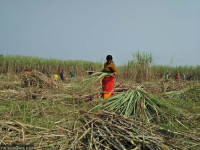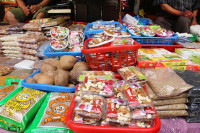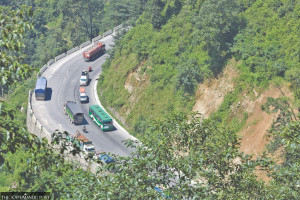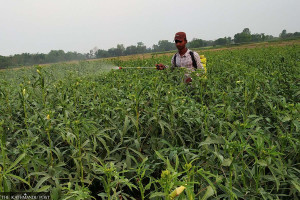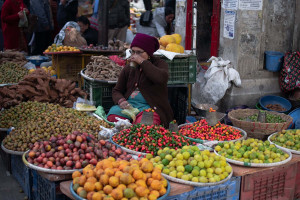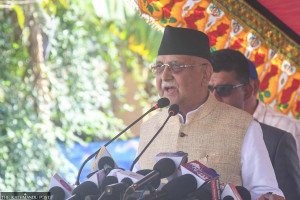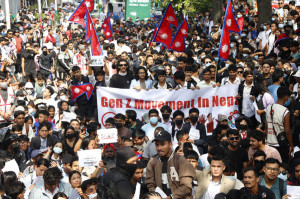Money
Gold price surges to Rs176,800 per tola
Trump’s threats of tariffs and additional duties on Chinese goods have intensified fears of a global trade war, turning investors to gold.
Post Report
The price of gold in the Nepali market has continued to rise, and bullion traders expect it to reach Rs200,000 per tola soon.
Diyesh Ratna Shakya, senior vice president of the Federation of Nepal Gold and Silver Dealers Association, stated that international factors have contributed to this surge.
He explained that US President Donald Trump’s increase in customs tariffs has raised inflation in the US, turning investors to the gold safe haven.
In November last year, gold prices in the domestic market reached Rs167,200 per tola, prompting the government to cut customs duty by nearly 10 percent to align prices with those in India and curb smuggling.
As a result, the price dropped to Rs151,300 per tola. Before this, the budget for the current fiscal year had raised the customs duty by 5 percent, bringing it to 20 percent. Despite these measures, the price of gold has continued to rise.
On Sunday, the bullion market opened at Rs176,800 per tola, an increase of Rs600 from the previous day. Last Friday, the market price was Rs176,200 per tola.
Over the past month, gold prices have risen by Rs8,700 per tola; over the past year, the price has increased by Rs46,800 per tola. In the last five years, the cost of the yellow metal has surged by Rs99,300 per tola.
The soaring prices have impacted consumer demand, as purchasing power has declined.
Shakya, who owns Suwarna Jewelry in Kavre, Banepa, noted that demand is currently low due to the off-season. However, traders anticipate some transaction recovery with the wedding season beginning in mid-April.
There is concern, however, that prices might reach Rs200,000 per tola by then.
Previously, when gold was priced below Rs100,000 per tola, daily transactions during the wedding season ranged between 40 and 50 kilos. Now, with prices consistently breaking records, demand has dropped to 15 to 20 kilos per day.
On regular days, few customers purchase gold, most opting to exchange old jewellery or add small amounts to their existing pieces. Some customers also visit bullion shops to sell their gold jewellery.
On Sunday, gold prices reached $3,090 per ounce in the international market.
According to global reports, investors are turning to gold as a safe-haven asset in response to escalating global trade tensions and tumbling equity markets triggered by President Trump’s announcement of new auto tariffs.
Gold is traditionally considered a hedge against economic and political uncertainty and often thrives during low interest rates.
Trump’s threats of trade tariffs and additional duties on Chinese goods have intensified fears of a global trade war, affecting currency markets and increasing concerns about inflation in the US.
The global trade war has already unsettled financial markets and heightened recession fears. Trump recently announced a 25 percent tariff on imported cars and light trucks, effective this week.
Last Wednesday, Goldman Sachs revised its end-2025 gold price forecast to $3,300 per ounce, up from $3,100, citing stronger-than-expected exchange-traded fund inflows and sustained central bank demand. In recent years, central banks’ demand for gold has remained robust due to macroeconomic and political uncertainty.
The World Gold Council reported that global gold demand, including over-the-counter trading, rose by 1 percent to a record high in 2024, with central banks accelerating their purchases in the fourth quarter.
In Nepal, gold is not allowed as an investment, though it can be used as collateral for bank loans. Traditionally, people have used gold ornaments and jewellery as security when borrowing money from local lenders.
Shakya noted that if the Nepali currency had depreciated further, gold prices would have surged even higher. Bullion traders believe there is little chance of gold prices declining unless the US revises its trade policies.
In February, the Nepali rupee hit an all-time low, with Nepal’s central bank fixing the exchange rate at Rs140.43 per US dollar. The rate has since fallen to Rs137.06.
Gold imports declined 10.85 percent in the first eight months of the current fiscal year until mid-March.
According to the Department of Customs, Nepal imported 1,188 tonnes of gold worth Rs14.37 billion during this period, mainly from Turkey and the United Arab Emirates. The country’s total gold imports stood at Rs25.41 billion in the fiscal year 2024-25.




 17.12°C Kathmandu
17.12°C Kathmandu